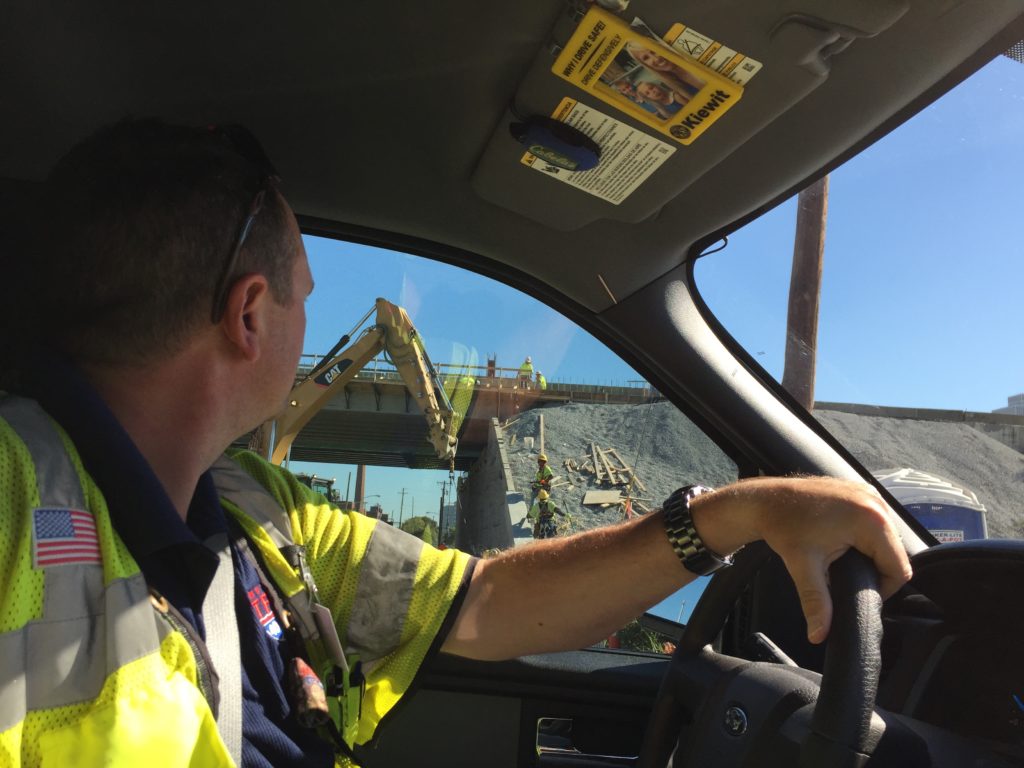
Crane-spotting has become a pastime in Nashville, but it’s possible to overlook the most powerful equipment in town.
They’ve not been towering next to new buildings, but instead doing the grunt work of replacing eight Interstate overpasses around downtown as part of the
“Fast Fix 8” project by the Tennessee Department of Transportation
.
Across the state, the agency had never used such mighty machines before, but they’ve gained a cult following online and kept the record-setting project on schedule as they tear down eight bridges from the 1960s
and bring in replacements.
Planners chose to do the work by
completely closing parts of the interstate loop while using what’s known as “accelerated bridge construction.”
Project manager Marc Rothwell, with Kiewit Construction, oversees the heavy haulers. And when he talks about them, he sounds like a coach who loves having a deep reserve of all-star players. He refers to having second and third-string backup tractors on hand so that when they break down — it’s inevitable — there won’t be delays while demolishing and replacing an old bridge in just 58 hours.

Most unique are truck cranes that can lift 300, 500, and even 660 tons. That’s serious power, and as much as ten times stronger than the tower cranes dotting the surrounding skyline.
The rolling behemoths make it possible to lift — or in the lingo, to “pick” — pre-made bridge spans and then slide them into place. That includes some of the longest and heaviest pre-made spans ever installed in the U.S.
“Absolutely, your adrenaline gets going and people are like, ‘Man you need to go home,’ ” Rothwell said. “And most of our guys, they can’t, because you can’t get home and sleep, because you’re worried … you’re getting a text message every five minutes that says, ‘Hey, we just set panel two.’ “
To pull off the installations, the team keeps minute-by-minute flip charts with drawings of how the span should look. They’ve fallen behind at times, but caught up.
“It’s exciting,” Rothwell said. “It’s the most fun you can have doing this kind of work, I can guarantee you that.”
Cult Following
The spectacle is catching attention. For one, on each closure weekend, crews have reopened the highway several hours ahead of schedule, containing the detour to the period between 8 p.m. Friday and 6 a.m. Monday.
TDOT is stoking interest with
time-lapse and explanatory videos — now viewed more than 45,000 times on YouTube.
“We’re getting tweets, for instance, from Yazoo’s brewer, who wants to go buy all these guys a beer after watching the time-lapse video,” spokeswoman B.J. Doughty said. “People are getting into watching this. When they see what looked like a bunch of chaos, all of sudden, you’re like, ‘Oh my God, there’s a bridge sitting there.’ “
It’s such a curiosity that people have pulled off the side of the interstate to ask questions.
Officials warn against that.
But the last big installation will be over Charlotte Avenue, and they’re inviting crowds to watch that on the last weekend in October.
“They’re going to be around 320,000 pounds,” Rothwell said. ”
We’ll pick ’em, walk ’em out on to [Interstate 40], drive ’em approximately a mile … takes about 30 minutes, and then off-load them with two 600-ton hydraulic cranes and set ’em into place.”
‘Failure Is Not An Option’
Even further behind the scenes, TDOT officials are hoping to celebrate a project that actually required a change in state law. The bidding process is considered one of three pilot efforts in which private contractors are enlisted earlier on, at the design phase, instead of just bidding to carry out the construction.

“If we were going to build this project conventionally, just in construction time, we’re talking about three years,” said Will Reid, TDOT director of construction.
“The public really likes the fact that we can get in and get out,” he said. “Obviously there’s an inconvenience associated with it … but we have made the decision that in this case, with I-40 in downtown in a city that is absolutely booming, that it made sense for us to be aggressive.”
Among the “Fast Fix 8” stickers and reflective vests for construction workers, the team also uses the mantra, “Failure is not an option.” Thus far, Reid said, the project is running smoothly.
Rothwell said the work “absolutely” isn’t any easier, but it’s less impact on the public.


